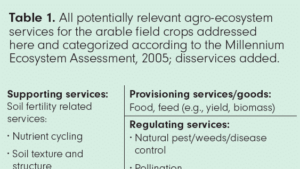The outcomes from last October’s biodiversity and biosafety meetings in Nagoya, Japan are welcomed by the international plant science industry.
Historic decisions adopted at the Nagoya Biodiversity Summit, as well as a meeting of the parties to the Cartagena Protocol on Biosafety last October in Nagoya, Japan, will improve access to genetic resources and support the international trade of seed, say industry experts. “The outcomes of the Nagoya meeting were welcomed by the plant science industry—they provide workable systems which will improve access to genetic resources and agricultural biotechnologies, while helping to ensure smooth international trade flow,” says Denise Dewar, executive director for plant biotechnology at CropLife International, a global federation representing the plant science industry.
In fact, reaction by seed industry experts to the decisions adopted at the tenth meeting of the Conference of the Parties (COP 10) to the Convention on Biological Diversity and the fifth meeting of the Conference of the Parties serving as the meeting of the Parties to the Cartagena Protocol on Biosafety (COP-MOP 5), has been enthusiastic and encouraging.
The adoption of two international treaties at COP-MOP 5 and COP 10—the Nagoya Protocol on Access to Genetic Resources and the Fair and Equitable Sharing of Benefits Arising from their Utilization and the Nagoya-Kuala Lumpur Supplementary Protocol on Liability and Redress to the Cartagena Protocol on Biosafety—is widely supported by members of the seed industry.
“For several years, the delegates to the Convention on Biological Diversity have worked tirelessly to advance science-based regulations on access and benefit sharing, and the transboundary movement of living modified organisms. The plant science industry applauds them for the successful negotiations on these two issues during the October 2010 meetings in Nagoya, Japan,” says Dewar.
The Nagoya Protocol on ABS, a legally binding international treaty, creates a framework that balances access to genetic resources on the basis of prior informed consent and mutually agreed upon terms with the fair and equitable sharing of benefits, while taking into consideration the important role of traditional knowledge.
Dewar, and the regional and national associations she represents in over 91 countries, welcomes the adoption of the Nagoya Protocol on ABS: “After seven years of negotiation, the plant science industry is pleased that the Nagoya Protocol on Access to Genetic Resources and the Fair and Equitable Sharing of Benefits Arising from their Utilization was adopted. The plant science industry has long supported the creation of a practical, workable and cost-effective international regime on ABS that promotes transparency and legal certainty to justify business investments at the national level. The Nagoya Protocol provides users of genetic materials with legal certainty that those resources were acquired with prior informed consent, recognizes the special nature and importance of genetic resources for food and agriculture, and their role in achieving food security worldwide, alleviating poverty and addressing climate change,” says Dewar.
The adoption of the treaties ends the United Nations’ International Year of Biodiversity on a triumphant note, marking a promising new beginning to the preservation of biological diversity.
According to Ahmed Djoghlaf, executive secretary of the CBD, the Nagoya Protocol on ABS, which is expected to enter into force by 2012, provides benefits for all participants. “By giving greater legal certainty and clarity to both users and providers of genetic resources, the Nagoya Protocol will provide an incentive for public and private sector research while ensuring that a fair and equitable share of benefits arising from this research accrues to the countries providing the genetic resources,” he says. “Hence, the protocol, by improving the current situation for all sides, and while strengthening compliance and monitoring frameworks, will promote biodiversity conservation while contributing to the long-term profitability of industries that draw upon genetic resources, such as the seed industry.”
Prior to the biodiversity summit, seed industry experts were concerned about the role existing treaties addressing access and benefit sharing would play in the proposed protocol. Of particular importance to the industry was the recognition by the proposed protocol of the International Treaty on Plant Genetic Resources for Food and Agriculture, and the exemption of crops and plants already covered by the ITPGRFA.
After negotiations at COP 10, the Nagoya Protocol on ABS acknowledged the fundamental role pre-existing agreements and guidelines for access and benefit sharing, such as the ITPGRFA and the Food and Agriculture Organization’s Commission on Genetic Resources for Food and Agriculture, play in ensuring the continuous flow of genetic resources for plant breeding.
Both Dewar and Bernice Slutsky, vice president of science and international affairs for the American Seed Trade Association, welcome this outcome: “Our primary concern was that the ABS regime, under the CBD, recognizes the International Treaty and the role it plays,” says Slutsky. “The language [of the Nagoya Protocol] does this. We are pleased the role of the International Treaty was specifically included in the text. We continue to think that the International Treaty is best placed to address access and benefit sharing for agricultural products,” she says.
Dewar says the adoption of the Supplementary Protocol on Liability and Redress was also a hard-won victory for biodiversity and the seed industry. “The adoption of the Nagoya-Kuala Lumpur Supplementary Protocol on Liability and Redress to the Cartagena Protocol on Biosafety establishes a workable system for response to damage to the conservation and sustainable use of biological diversity caused by living modified organisms.”
The Cartagena Protocol on Biosafety, a supplementary treaty to the CBD, will establish international rules and procedures for liability and redress in case of damage to biological diversity resulting from LMOs. To date, 159 countries and the European Union have ratified the protocol.
The Supplementary Protocol was adopted a few hours before the opening of COP-MOP 5. Moving ahead, Slutsky says attention should now be placed on national governments and the implementation of the protocol. “Governments need to ratify the Supplementary Protocol—if they’re a party to the Biosafety Protocol that doesn’t automatically make them a party to the Supplementary Protocol—they have to separately ratify the Supplementary Protocol. It is important for governments, if they are considering ratification, to do an analysis of their own laws and determine how they will implement the Supplementary Protocol. Governments must have the tools at the national level in order to implement any treaty. Some governments will not have to do anything to implement once they ratify the treaty, some will have to put mechanisms in place,” she says.
Since 2008, CropLife International has been developing the framework for an objective and independent procedure for evaluating and arbitrating claims of, and remedying damage to, biological diversity. Recently, CropLife announced the implementation of The Compact, a contractual mechanism for a clearly defined, effective, and fair resource process in the event of damage to biological diversity caused by an LMO, as a complement to the Supplementary Protocol. Reception of The Compact when presented to CBD delegates at the Nagoya Biodiversity Summit was positive and supportive of the new framework developed by CropLife.
In order to secure both access to food and the preservation of biodiversity, Dewar illustrates the importance of working together in this way. “Today, more than ever, food security and biodiversity are both at risk due to the increased demands of a growing p
opulation. The plant science industry is committed to helping farmers grow abundant, safe, and nutritious food for expanding populations, while maintaining and preserving natural resources. We appreciate the hard work of the delegates to the Convention on Biological Diversity in furthering policies that support science-based regulation and innovative plant science technologies that safeguard biodiversity and agricultural production.”
The relationship between agriculture and biodiversity is a close, mutually beneficial one, and the importance of sustainable, accessible, diverse genetic resources to plant breeders cannot be understated. “Agriculture and biodiversity have a symbiotic relationship—agriculture is both reliant on a rich ecosystem, and good agricultural practices are critical in helping to protect biodiversity and limited natural resources. Plant breeders have long relied on diverse plant genetic resources to facilitate the exchange of desirable traits to improve crop yields, increased pest and virus resistance and to enhance nutritional content,” says Dewar.
Governments also agreed on a package of measures to meet the challenges of biodiversity loss and climate change at the summit in Nagoya. The Strategic Plan, also known as the Aichi Target, was adopted at the summit. The Aichi Target is a ten-year strategic plan to guide international and national efforts to save biodiversity through enhanced action to meet the objectives of the Convention on Biological Diversity, which are the conservation of biological diversity, the sustainable use of its components and the fair and equitable sharing of the benefits from the use of genetic resources.
The meeting also put in place a resource mobilization strategy providing a way forward to a substantial increase in current levels of official development assistance in support of biodiversity. The next meeting of the Conference of the Parties will take place in 2012 in India. Kari Belanger













